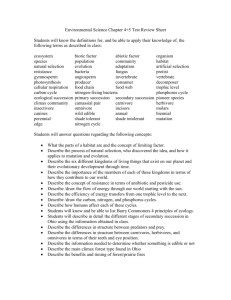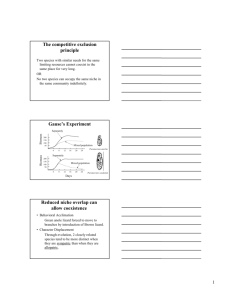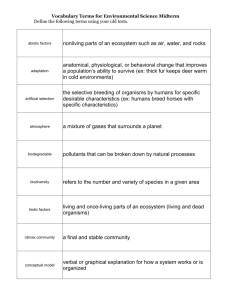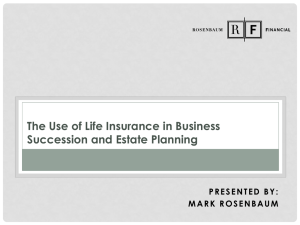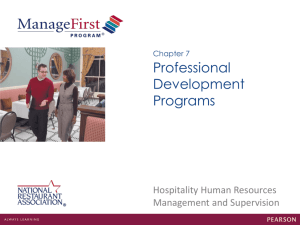Succession Planning and Management
advertisement
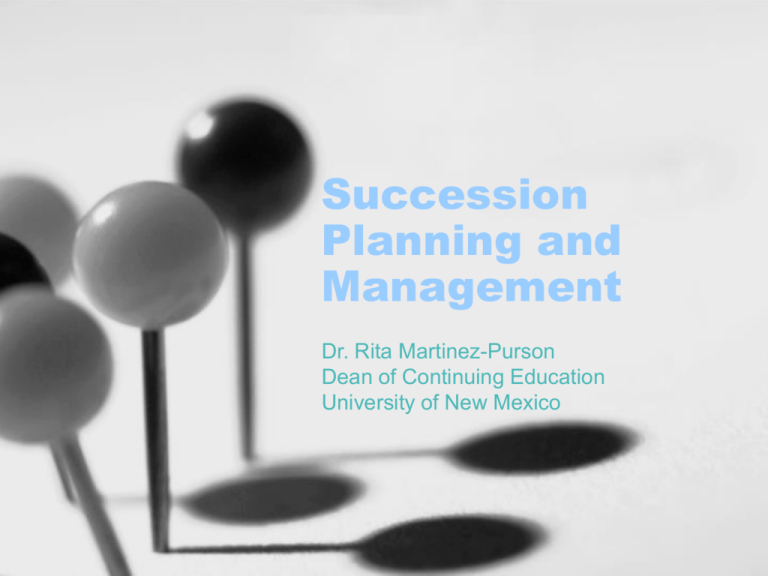
Succession Planning and Management Dr. Rita Martinez-Purson Dean of Continuing Education University of New Mexico We need to plan and develop the future leadership for CE units • We face an aging workforce and looming retirements • Our best people are more likely to leave in a competitive job market • We are concerned about retention, knowledge transfer, continuity of operations What is Succession Planning and Management? A deliberate and systematic effort that ensures: • Leadership continuity in key positions • Retention and development of intellectual capital for the future • Encouragement of individual advancement Succession vs. Replacement Succession Plans • Long-term: 12-36 months • Focus on future leadership • Develops leaders capable of filling multiple assignments Replacement Plans • Short term: 0-12 months • Focus on immediate needs • Develops back-up staff for key positions How does it happen? We apply specific procedures to insure that talent is: • Identified • Developed • Retained Traditional approaches to meeting succession needs In • Up • Down • Across • Progress in Place (career ladders) Out Roles and Involvement • • • • Leadership Champions Human Resources Team Dialogue Teams within organization Internal Employees identified for possible succession • Outside facilitators, recruiters • Other outside organizations as sources for recruitment I. Planning: Internal Discussions 1. Succession needs and priorities 2. Environmental Scan 3. Work functions: now and in future 4. Demand: Staffing level, skills, titles 5. Supply: likely availability of workers 6. Gaps: priority needs 7. Solutions: what specific actions will you take to address the priorities? Next: Identify potential internal candidates • Quality performance review process that assesses Skills, Knowledge, Abilities and Potential promise for key positions. • Inquiry as to level of interest in advancement to key positions II. Implementation of the Succession Plan • • • Conduct Succession Planning Training for the organization’s leaders Analyze critical skills and the workforce Address critical skills shortages II-A: Internal Candidates Advantages Disadvantages • Provides rewards and incentives for great employees • Cost effective • Morale-boosting • Organizational inbreeding • Possible infighting or jockeying for position • Heavy load on training and development Development of Internal Candidate Pool • Training Programs • Mentoring Plans • Implement “Emerging Leaders” and “Advanced Leaders” development programs • Meaningful performance reviews and goal setting • Career ladders • Mentor/supervisory feedback processes Human Resource Development Components • Training: Based on skills, knowledge and abilities in present job • Development: Preparing for future responsibilities • Organizational Development: Planning interventions to enhance organizational effectiveness • Career Development: Planning and managing career stages Career Development Where career plans are developed, implemented and tracked • • • • Employee self-assessment Employee development systems Individual coaching/counseling Job matching systems II-B: External Applicants Sources may include: • Former employees • Referrals from colleagues and employees • Previous applications • Professional associations • Internet applicant pools • Search firms and agencies • Advertising and walk-in applicants Decision: Internal or External? Depends on • Organization’s needs, culture and philosophy • Geographic location • Labor pool for level of positions to be filled • Pay and benefits • Time and budget constraints • Affirmative Action goals • Labor Union obligations III. Evaluation Make your succession planning efforts a learning opportunity. • Evaluate the success of job filling goals • Evaluate whether planned career development has taken place A We Want to Become an Employer of Choice Become an employer of choice by: • Ensuring work-life balance • Providing opportunities to learn and advance • Give incentives for top performance • Keep “spirit” in the workplace • Have a participative environment Further information… Winning the Talent Wars: Bruce Tulgan Career Planning and Development William J. Rothwell et al. Effective Succession Planning: William J. Rothwell. Email: rmpurson@unm.edu


